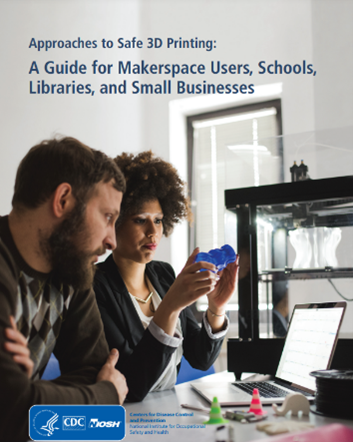Safe 3D Printing is for Everyone, Everywhere
Posted on by
Three-dimensional (3D) printing has become more popular in recent years. These printers can create objects by building them layer by layer from a digital design. 3D printing is an important part of modern innovation because it speeds up the design and testing of new ideas. It can also help produce complex and precise parts.
The National Institute for Occupational Safety and Health (NIOSH) is working to minimize the potential health and safety risks from using 3D printers. In 2023, NIOSH published Approaches to Safe 3D Printing: A Guide for Makerspace Users, Schools, Libraries, and Small Businesses, a 40-page guide on the proper use of 3D printers.
More American workers have access to 3D printers. You can also now find 3D printers in schools and libraries. Makerspace users and small business owners are also common users of 3D printers. Currently, makerspaces, schools, libraries, and small businesses mostly use two kinds of 3D printers: fused filament fabrication and vat polymerization. Fused filament fabrication involves melting a thermoplastic filament and placing this molten plastic in the desired shape using a moving extruder. Vat polymerization involves using UV light from a laser or projector to cure photopolymer resin in exactly the desired shape. In each case, once a layer is deposited, the build platform is moved vertically to allow creation of another layer.
Health and safety risks from using 3D printers
Using a 3D printer can pose several health concerns. These include potential exposure to ultrafine particles (particles smaller than 100 nanometers) and chemicals, and other possible safety hazards. To understand these risks better, NIOSH evaluated emissions from different printer and filament combinations in both laboratory and workplace settings. Hazards may occur during different stages of 3D printing, including pre-printing, printing, post-printing, and maintenance and cleaning activities. Health and safety hazards vary, but can include:
- Volatile and semi-volatile organic compounds and ultrafine particles.
- Solvents, which may be flammable, create hazardous or explosive vapors, cause eye or respiratory irritation, or potentially cause cancer.
- Heat, which may cause burns from contact with hot surfaces.
- Moving parts, which can trap hair, fingers, and clothing.
- Lasers, which might become unguarded during maintenance and can cause damage to eyes or skin.
- Electrical hazards, which are primarily a risk during maintenance, malfunction, or improper use.
- Noise, particularly when several printers are used in a single room.
- Collision with any automated robotic assistance (if used).
- Take-home exposures, which can expose family members, especially by home-business users.
Steps that 3D printer employers, managers, and users can take
Employers and managers of makerspaces, schools, libraries, and small businesses should write a comprehensive risk management plan for 3D printing (see Section 4.1 of the guide). The plan should describe the hazards related to each of the work activities (pre-printing, printing, post-printing, post-processing, maintenance, and cleaning). It should also provide best practices and standard operating procedures that follow the hierarchy of controls (Section 4.2) to reduce potential hazards. The hierarchy of controls prioritizes actions based on the effectiveness of controls: elimination, substitution, engineering, administrative controls, and personal protective equipment.
Users should be aware of the potential health and safety risks and take appropriate safety measures when 3D printing.
Here are some examples of ways to manage potential risks at each level of the hierarchy of controls:
- Focus on risk management strategies near the top of the hierarchy of controls, such as eliminating or substituting the hazard. These controls are most effective. This is especially important in makerspaces, schools, libraries, and small businesses, where users have differing levels of experience and safety knowledge.
- Substitute less hazardous materials and processes where possible.
- Use engineering controls such as proper ventilation and high-efficiency particulate air filters to provide effective source control. Some printers have optional features or modifications to better control emissions, which can be very cost-effective.
- Implement administrative controls such as creating risk management plans, policies, and encouraging safe behaviors to reduce risk. The effectiveness of these controls depends on employer commitment and user acceptance.
- Use personal protective equipment as a last resort since it’s the least effective control. Select appropriate protection based on anticipated hazards. This may include eye protection, chemical and thermal-resistant gloves, and respiratory protection.
As 3D printing becomes more popular, more people will be using these printers and be exposed to their potential hazards. Users may be in settings beyond the traditional workspaces, such as makerspaces, schools, libraries, or small businesses.
You can take steps to protect your health and safety when 3D printing. Approaches to Safe 3D Printing: A Guide for Makerspace Users, Schools, Libraries, and Small Businesses can help keep you, your coworkers, and others safe.
Use our 3D Printing Postcard and 3D Circle QR codes to remind yourself and others to practice safe 3D printing! Download and print these images here.
We want to hear from you! Use the comment box below to share your thoughts and questions.
Where do you 3D print? What safety and health controls are in place right now?
Did you print these QR codes? Where are you going to put this sticker, to remind everyone to practice safe 3D printing?
Gary Roth, MS, PhD, is a health scientist in the NIOSH Division of Science Integration, Emerging Technologies Branch.
Grace Vixama, MPH, CHES is a health communication specialist in the NIOSH Division of Science Integration, Science Application Branch.
Posted on by

